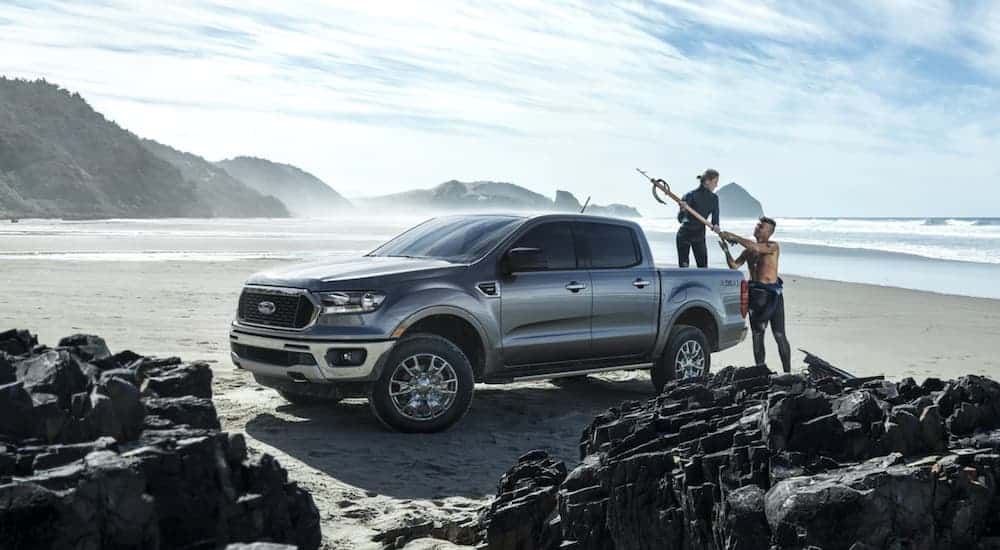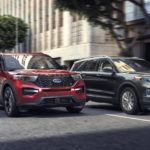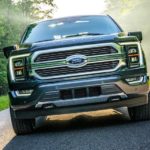Today’s mid-size pickup truck is, comically, virtually identical to a full-size truck of the 1990s. The phrase “power creep” comes to mind, which comes from the gaming industry. It refers to a phenomenon where anything new that gets introduced to the game after the initial release is more powerful than alternative choices in order to generate interest in the new option. It applies to the pickup truck segment as well – how can Chevy or Jeep win over Ford Ranger buyers without offering something bigger and stronger, and how can Ford retain customers without matching or exceeding those gains? As a result of this “power creep,” the 2021 Ford Ranger’s size and capabilities compare well to the F-150s of previous decades.
The 2021 Ranger measures up against old F-150’s in one other way – exterior styling. Don’t forget that although the current Ranger truck generation entered the US market in 2019, the current generation of Ranger has been sold worldwide since 2012. That’s not quite so far removed from the 10th and 11th-generation F-150s that it looks like. It’s a signature look, which stands the test of time but is outdated enough to be a bit of a mixed bag in terms of appeal. But I’ve got to say; I was taken aback when I saw pictures of the 2021 Ford Ranger in Lariat trim dressed in Velocity Blue paint and chrome accents. With gleaming chrome on the bumpers, grille, and wheels, the truck sparkles like a sapphire ring – and avoids the over-done look of chrome-plated window frames or sun shields.
Chrome isn’t as popular as it once was. Exaggerated body lines highlighted by chrome inserts and massive chrome-plated bumpers are signature features from the ’50s, but aerodynamic plastic with body-color paint has been the modern standard for a long time. In most cases, I think the uniform body coloring looks better anyway, but this particular image of a chromed-up Ranger really struck a chord. There’s a lot more to chrome than the look, of course, and the process of making a chrome-plated part is a serious one, so let’s peel back the curtain a little bit and take a glimpse at what goes into an automobile’s most eye-catching features.
Why Chrome?

There’s a lot more to chrome than a beautiful bluish-white mirror finish. Chrome is actually harder than steel and remarkably corrosion resistant. You may be aware that chromium is the primary additive that puts the “stainless” into “stainless steel,” making it an excellent choice for protecting bumpers. Not only can the harder chrome shell resist heavier impacts, it won’t rust and flake away even if it does sustain damage. Stunning aesthetics aside, chrome plating makes sense for practical purposes alone, especially if your exposed metal bumpers are apt to take a beating! This is likely the reason why chrome bumpers are still popular on trucks but have virtually disappeared from passenger cards.
Why Not Chrome?
Despite the benefits of this tough outer shell, plating with chromium is problematic. Plated chromium metal and trivalent chromium ions (in chemistry, this means a chromium atom with a positive charge that would be neutralized by pairing with 3 electrons) are harmless. However, hexavalent chromium – the type of chromium ion used in plating applications – is a dangerous known carcinogen, making waste disposal a challenge and safe processing even more so. On top of this, hexavalent chromium exhibits poor “throwing power,” which is another way of saying that it can’t mask surface imperfections by filling in little pits and scratches, meaning the parts being plated need to be in pristine condition to achieve an acceptable finish. These challenges result in substantially higher costs from chrome-plated parts than alternative finishes.
Yikes. Options?
While it lacks the exotic connotations of chromium, nickel is actually an excellent substitute in most applications. It can form compounds that are harder and even more corrosion-resistant than chrome, and its natural silvery shine only differs subtly with a mild yellow tinge to chrome’s blue. Nickel-tungsten alloys provide enormous heat resistance and offer a more efficient plating sequence than chrome, while nickel impregnated with silicon carbide particles has great wear resistance. Then there’s “electroless nickel” (meaning that the nickel, suspended in a chemical solution, naturally deposits on submerged parts without using an electric current to drive the reaction), which easily produces a uniform coating and provides similar corrosion resistance to chrome for mechanical components.
Considering that modern chrome plated parts rely on an expensive nickel layer to achieve their distinctive shine, the aesthetic tradeoff to get something that’s easier and a lot less dangerous to make could be well worthwhile. However, chrome plating professionals have decades of experience safely and expertly handling their processes, so those who feel it’s chrome or nothing shouldn’t feel guilty for their preference. Consider the choice to be one of cost and appearance.
You Mentioned a Process?
Chrome car parts are rarely, if ever, made of solid chromium metal. It’s a question of cost-benefit – chromium is more expensive and harder to process than steel or aluminum. In most places where we care about having chrome, the structural needs of the part are perfectly met by steel and aluminum, so all we really need chrome for is a plated surface to provide an untarnishable finish. The process of applying chrome plating is a long and involved one, with equal parts mechanical and chemical, demanding incredible patience and attention to detail to ensure a robust, blemish-free product.
One key piece of terminology to understand with regards to plating processes is electroplating vs electroless plating. Both involve chemical baths which contain dissolved metals (like salt in a chicken noodle soup) and immersing the product in those baths to allow the dissolved metals to latch onto the product and create a thin, uniform layer. The difference is in how that latching takes place. An electroplating process uses carefully applied voltages and electrical currents to drive the reaction. As long as the product is electrically conductive, this is a stable and highly controllable way to perform plating.
Electroless plating is necessary when the product is not conductive; without an electric current flowing through the product, electroplating doesn’t work. An electroless process uses a very sensitive chemical bath that deposits metal on everything it touches. In this way, a piece of plastic trim can be covered by electroless copper so that it can then undergo electroplating thanks to the new conductive layer.
Now That We’ve Got the Basics Down
Those are the basics. But applying chrome plating to the trim of the 2021 Ranger isn’t as simple as dipping each piece into a chromium electroplating bath. I already mentioned that hexavalent chromium has poor throwing power, so the parts need to be perfectly smooth before the chrome is applied. Whether you’re restoring an old piece or plating something brand new, steps are needed to ensure the smoothest surface and most brilliant color.
It begins by removing damaged layers if present. Sodium hydroxide, an extremely powerful base also known as caustic soda, does an excellent job removing paint while soaking at 75 C (roughly 167 F). After a long soak, paint and excess chemicals can be easily washed away. Even old chrome and nickel layers can be removed in a reverse electroplating process, where the applied voltage actually causes the old chrome to dissolve off of the part, allowing us to start fresh. Finally, metallic parts are polished and chemically etched in hydrochloric acid to create a clean, uniform surface to begin with.
For restoration jobs, any dents and defects in the original part can now be worked out by skilled metalworkers. This is easier said than done since chrome won’t hide any scratches, dents, or welding patches that remain in the part. Once the parts look exactly the way we want them to and we’ve thoroughly polished the surfaces, the plating process can begin. Electroless copper (if needed) and then electroplated copper are added, with an electric current passing to the parts through a copper clamp or wire. Copper has relatively good throwing power, meaning that remaining imperfections will be mostly filled in by this process, which creates the foundation for the multilayer plating that is to come.
After another round of buffing and polishing to produce a mirror finish, plus rinses to ensure all chemicals and particles are removed, the all-important nickel layer is next. A base semi-bright layer of electroplated nickel provides corrosion protection for the underlying copper, while an outer bright nickel layer (up to 45 microns thick!) supplies the underlying shine so iconic to chrome parts. This is because the chrome layer is only going to be a fraction of that thickness – enough to provide a bluish tinge and extra corrosion resistance, but not so much as to form a significant structural layer for the parts.
To apply that layer, an auxiliary anode – that is, a positively charged object which will attract electrons during electroplating to help direct the electric current – can be attached to the part in strategic locations to ensure the best uniformity possible. Then it only takes a short dip in an orange chromic acid bath to deposit roughly 3 microns of chrome over the nickel, finishing the plating cycle!
Not Everything is Chrome in the Future
When chrome electroplating was developed in the first half of the 20th century, its use was synonymous with futurism. Vehicles of the 1950s and 60s nearly had more chrome than paint, from the grilles to the bumpers to the window trim to the dashboards. All of the coolest, most futuristic vehicles made extensive use of chrome to finish and highlighted their wild and impractical designs. It surely seemed like the future of the world was brilliant, gleaming chrome.
But not everything is chrome in the future. Smooth plastic bumper covers and black or body-colored highlights have won the day for now. Many vehicles, especially trucks, continue to offer chrome-themed appearance packages straight from the manufacturer, and there’s always the option of aftermarket parts if the space-age look of chrome strikes your fancy. To this author, chrome on modern vehicles is easily overdone, which is a shame when you consider what it takes to make a chrome-plated part. But I’d also say that on the 2021 Ford Ranger Lariat, the look that chrome can still achieve is worth every single penny.





